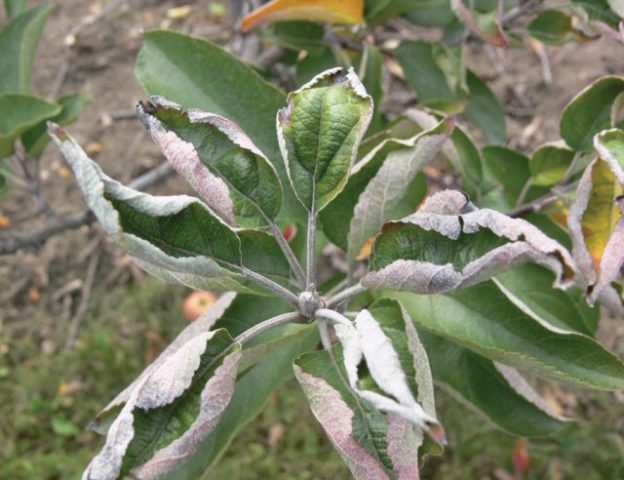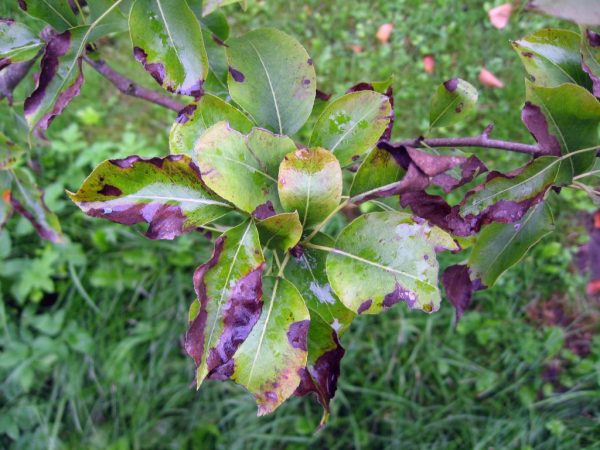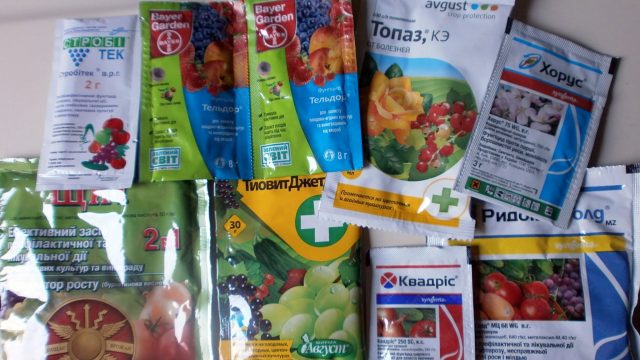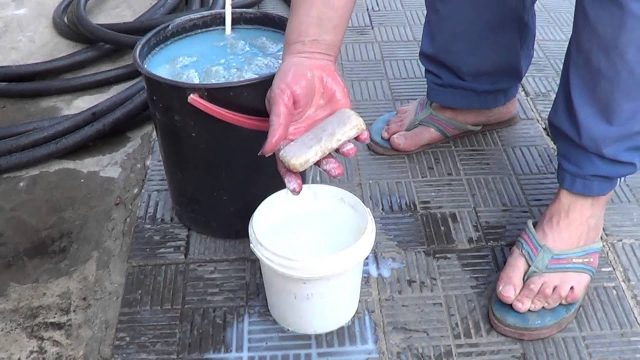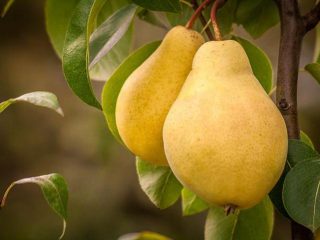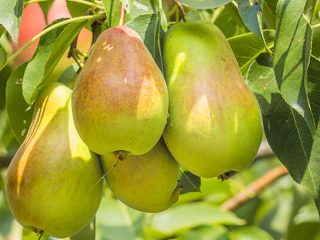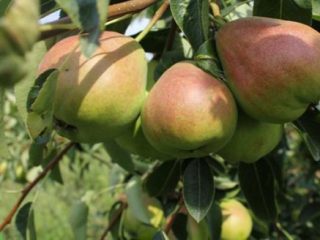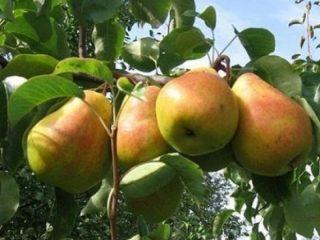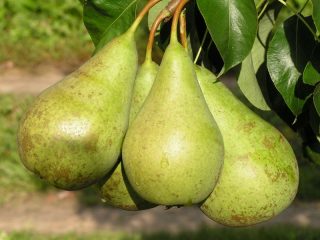Content
Curled pear leaves are a fairly common problem that most gardeners face sooner or later. Often this phenomenon is accompanied by a change in the color of the leaves, the appearance of brown and yellow spots on the leaf blade, and even the dropping of leaves. The reasons for curling of pear leaves include errors in planting care, infectious diseases, and pests.
Why do pear leaves curl into a tube?
At the first signs of leaf curling on a pear tree, it is necessary to carefully examine the tree - timely diagnosis helps to correctly determine the cause of the disease. Depending on what caused the deformation of the leaf plate, they choose how to treat the plantings.
Improper care
In most cases, the cause of leaf curling is gross violations of agricultural practices for planting and growing pears. In particular, the most common errors include:
- lack or excess of moisture in the soil;
- overfeeding of plantings or, conversely, lack of fertilizers;
- improper preparation of the tree for winter, as a result of which the roots of the pear freeze due to low temperatures;
- weakening of the pear due to excessive harvest;
- mechanical damage to the tree when caring for it, which can lead to infection of the pear with fungus.
Contrary to erroneous belief, an excess of nutrients does not always benefit the plantings and harms the pear in the same way as a lack of fertilizers. However, leaf curling is caused primarily by low concentrations of certain microelements in the soil:
- A lack of calcium causes the leaves to first turn black and then curl at the edges, upward.
- The lack of a sufficient amount of boron in the soil is fraught with inhibition of shoot growth and a slowdown in the metabolic processes of the pear, especially in seedlings, after which the leaves begin to curl.
- Low phosphorus content causes shredding of pear leaves and subsequent blackening of the leaf blade. If the composition of the soil is not corrected in time, the tree will completely lose its leaves. An insufficient amount of phosphorus in the soil is observed when planting in acidic soil and in the absence of organic fertilizers.
- A lack of nitrogen is accompanied by lightening of the color of the foliage and its subsequent falling off.
- Pear leaves can also curl due to a lack of potassium in the soil. Then the process is accompanied by blanching of the leaves and curling of the very tips of the leaf blades downwards.
Diseases
Curling of pear leaves is most often caused by the following diseases:
- grooved trunk;
- bacterial burn;
- powdery mildew;
- scab.
Trunk furrowing affects pear trees in March-April and manifests itself in the form of large cracks in the tree bark. Through these crevices, various fungal infections penetrate into the core of plants, thereby disrupting the metabolic processes inside.Most often this happens in cloudy, humid weather, when a number of fungi become active.
At the first stage of the disease, the pear leaves curl, as seen in the photo below. Then the infection spreads to the fruits, which become covered with dark spots. In the final stages of the disease, the tree appears burnt.
Stem groove virus is usually transmitted during pruning or after grafting of pear trees. Most often, this disease affects young seedlings about 2 years old.
Bacterial burn is expressed in the rapid blackening and curling of foliage, however, the leaves do not fall off. In the later stages of the disease, the branches and bark of the pear die off. Most often, bacterial burn affects plantings during periods of prolonged rain. The infection spreads very quickly. Pear varieties that are not immune to this disease eventually die. Varieties resistant to fire blight recover in 2-3 years.
Powdery mildew attacks pear plantings in cool years with high air humidity. The peak of outbreaks of this disease occurs in early spring, especially if there is thickening of trees in the garden. It is at this time that it is recommended to inspect the pear leaves with particular care for possible infections.
The first sign of powdery mildew is the appearance of a whitish coating on the leaves. At the next stage of the disease, the leaf blade of the pear begins to turn yellow and dry out. Eventually the leaves curl and fall off.
Scab is a fungus whose spores are carried over long distances by the wind. In windy, rainy weather, the disease spreads very quickly.
The first sign of scab is the appearance of a brownish coating on the leaf blades of the pear. Soon after this, the fruit begins to crack and the leaves curl.
Pests
Typical pear pests that cause leaf curl include the following insects:
- aphid;
- pear itch;
- pear gall midge;
- pear tube gun;
- leaf roller.
What to do if the leaves of a young pear curl
When young leaves of a pear begin to curl, the most important thing is to correctly determine the cause of this phenomenon. Depending on this, the further plan of action is determined.
Agrotechnical measures
The curling of pear leaves is often accompanied by a number of additional phenomena: the appearance of spots of different colors, plaque, death of shoots, etc. These side effects help determine what nutrients the plantings need, after which the composition of the soil in the area around the tree trunk can be adjusted:
- Lack of nitrogen in the soil is replenished by enriching the soil with ammonium nitrate. To do this, dissolve 20 g of the substance in a bucket of water and pour the solution under the root, preferably in the evening hours, when moisture evaporation is lower. Instead of saltpeter, you can use a weak solution of urea, which is used to treat pear leaves.
- Phosphorus deficiency corrected by adding a small amount of superphosphate to the ground in combination with organic fertilizer.15 g of the substance is mixed with 10 kg of manure.
- Potassium deficiency corrected by loosening the tree trunk and subsequent fertilization of the pear with wood ash or potassium sulfate.
- If the tree does not have enough calcium, then it is fed by adding lime to the soil. To do this, the tree trunk circle is loosened and the soil is fertilized with 100 g of the substance. Before this, 2-3 buckets of water are poured under the pear. After 2-4 days of planting, they are fed with potassium sulfate, after which the tree trunk circle is mulched with humus.
The leaves on the pear also curl due to the soil drying out. If the soil is insufficiently moist, fertilizers are not absorbed by the roots of the plant, as a result of which the metabolic processes of the trees are disrupted. It is not recommended to flood the plantings, since high moisture content in the soil can cause root rot. To better retain water in the soil after rains and waterings, it is recommended to mulch the area around the tree trunk. For this you can use:
- peat;
- weeds;
- torn paper;
- tree bark or sawdust.
Chemicals
For leaf curling, pears affected by fungus or virus are treated with the following chemicals:
- If the cause of twisting is a bacterial burn, then the trees are disinfected with antibiotics. 2 tablets per 1 liter of water are enough. The solution is sprayed on the shoots and leaves of the pear. All diseased shoots are cut out, including a healthy area, and the cutting tool is then thrown away.
- Another remedy for bacterial burn is Bordeaux mixture, which is used to treat plantings 2-3 times during the growing season.
- Fungicides are effectively used against powdery mildew according to the instructions. The chemical drug “Topaz” is quite popular in Russia. It is impossible to delay the treatment of powdery mildew, otherwise the tree will die.
- For scab, pears are sprayed with biofungicidal preparations, for example, Fitosporin-M or Bordeaux mixture. If these remedies do not have the desired effect, the trees are treated with fungicides. To do this, you can use the drugs “Skor” and “Fitolavin”.
- A mixture of potassium nitrate (15 g), potassium sulfate (15 g) and ammonium nitrate (10 g) has proven itself well in the fight against scab. The resulting mixture is sprayed onto the pear from a spray bottle.
Sometimes curling of pear leaves is caused by pest activity. In this case, the plantings are treated with insecticides or special chemical solutions.
It is recommended to use the following remedies against pear gall midge:
- "Chlorophos";
- "Antiox";
- "Zolon";
- "Nexion";
- "Dursban".
Trees that have been infected by aphids are treated with the following preparations:
- "Metaphos";
- "Antio";
- "Wofatox";
- "Decis";
- "Trichlorol-5".
Against the leaf roller, it is better to use not potent insecticides, but biological compounds such as “Lepidocide” and “Bitoxibacillin”. Enzymes “Akarin” and “Fitoverm” are also suitable.
There are also a number of universal-use drugs that cope with most pear pests:
- "Kinmiks". The drug is used in March or April, before the buds open. Dosage of the product: 2.5 ml of the drug, diluted in 1 liter of water. The resulting mixture is diluted again in 10 liters of water and sprayed onto the plantings.
- "Agravertine". This product is suitable for treating trees before flowering. Solution proportions: 5 ml of substance per 1.5 liters of water. The mixture is diluted again in 10 liters of water.
- "Spark". 1 tablet per 10 liters of water is enough. This is a mild preparation, so it can be used both before flowering and during the formation of ovaries and fruiting.
All of the chemical treatments listed above have an intense effect on trees. Their use must be carried out in accordance with a number of rules, otherwise serious harm to plants can be caused:
- Insecticides and fungicides are used only according to the instructions.
- Chemical treatment is carried out only at temperatures from +16°C to +25°C.
- The last spraying of pears is carried out no later than 25 days before harvest.
- It is better not to delay treatment. In the first stages, it is much easier to cure plantings.
It is recommended to first combat the disease with traditional methods and agrotechnical measures, and only then resort to treatments with fungicides and insecticides.
Traditional methods
Traditional methods of dealing with curled pear leaves include the use of the following measures:
- A good way to prevent fungus is to treat trees with a solution of soda ash and liquid soap. Solution proportions: 50 g of soda and 10 g of soap per 10 liters of water.
- An alcohol solution also effectively copes with fungal infections. To do this, water and alcohol are mixed in a 1:1 ratio.
- A copper-soap solution can help even in the later stages of the development of a fungal disease. To do this, 150 g of grated soap is mixed with 5 g of copper sulfate and poured into 10 liters of water.The mixture is thoroughly stirred and sprayed not only on the diseased pear, but also on neighboring trees.
- Plantings are sprayed against aphids with a solution of celandine. It is prepared like this: 5 branches of celandine are finely chopped and poured with boiling water. 1 bucket is enough. The resulting mixture is infused for 5 days. Then 200 g of solution is mixed with 10 liters of water.
- Since ants are carriers of aphids, pears are protected from them using adhesive belts. These can be replaced with cheaper fly strips. They also contain leaf roller larvae, earwigs and cap moths, which cause pear leaves to curl.
Preventive measures
Treatment of a pear can take a whole season and there is no guarantee that the process will be successful. That is why it is recommended to regularly carry out preventive treatments of plantings and other preventive measures so that pear leaves do not curl into a tube:
- In March-April, trees are sprayed with Bordeaux mixture. It is prepared as follows: 100 g of copper sulfate is diluted in 8 liters of water. Then another 100 g of quicklime is added to the resulting mixture. A properly prepared solution has a bright blue color. Sometimes a dark sediment falls to the bottom.
- The appearance of leaf rollers and some other pests is prevented by whitewashing pear trunks in the spring.
- You can reduce the likelihood of fungal disease by timely cleaning of fallen leaves.
- To protect against pests, trapping belts or traps with bait are installed.
- Sanitary pruning of the pear crown is necessary to prevent scab.
In addition, it is necessary to monitor the level of soil moisture and the fertilizing schedule. It is also important to properly cover trees for the winter.
Conclusion
Curled pear leaves are a common phenomenon, but in most cases it can be corrected if the disease is not neglected. Moreover, a number of pear varieties resistant to infections and fungi tolerate leaf curling without much harm to development. The risk of disease is significantly reduced if you periodically treat the plantings as a preventive measure against fungus and pests. It is also important to monitor the composition of the soil and the condition of the top layer of soil - it should not dry out.
You can learn more about diseases of pears and other fruit trees from the video below:
